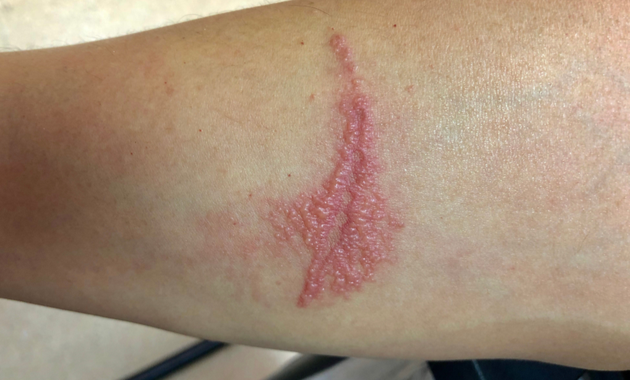
Insect bites are quite common and can happen all round the year. However, there are certain insects which do not bite but can lead to skin rash just by getting in close contact with the skin. Before you sit down and start guessing all is well and the lesion might subside on its own, you may observe a “mirror-image” lesion. Scary isn’t it? Well, such lesions could be because you came in contact with a printer insect. Wondering what is a printer insect? Here’s more to help you know everything about printer insect and what to do when you come in contact with a printer insect.
What is a printer insect?
A printer insect is one of the most common types of beetles (a common insect) and found all over the world. Mostly found in moist habitats such as irrigated farms as these insects breed in stagnant water. They can also be seen in toilets and in and around buildings under construction due to stagnant water. Printer insects are brightly colored insects which have metallic blue or green-colored fore wings and bright orange or red parts in the body. These insects are active during the day and get attracted to bright lights after nightfall. However, they are more attracted to white light as compared to orange and yellow light[1]. This is the reason, why the cases of printer insect lesions are observed mostly during Diwali due to the presence of bright lights during this festival[2].
Always Provide Initial Assistance Of Injury Or Illness With These Must Have First Aid Supplies
What happens if you come in contact with printer insect?
The printer insect does not bite or sting, but accidental brushing against the skin or crushing the beetle over the skin releases the insect’s fluid called hemolymph. This fluid contains a strong blistering chemical or toxin called pederin. Initial skin contact with this toxin shows no immediate result. But, within 12-36 hours a reddish rash may appear which may further develop into blisters. This can result in crusting and scaling on the skin, lasting for about two to three weeks. This characteristic skin irritation is called “dermatitis linearis” or “linear dermatitis” because accidentally dragging this beetle across the skin in a linear manner when trying to remove it can result in an inflammation which is linear as well.
It is also known as “wake and see” disease as the lesions are generally noticed on waking up in the morning. The reason being, one may not be able to detect contact with the printer insect while sleeping at night and crush it reflexly[1].
Lesions caused due to this insect are contagious and may spread on coming in contact with other parts of the skin. So, avoid touching the affected area as the toxin may unknowingly get transmitted to other parts of the body such as the eyes and genitals, causing infections like conjunctivitis, etc. If the lesion occurs on your arms or back of your legs, avoid flexing the area. It may develop into a “kissing” or “mirror-image” lesion or rash.
What to do if you come in contact with the printer insect?
Not just printer insect, if you see any insect sitting on your skin, do not drag the insect off. Instead, blow it away or make it walk onto a piece of paper and then remove it. However, in the case of printer insects, just removing it does not eliminate the chances of getting a lesion. According to some reports, this insect may release toxins even while moving.[1]
Here’s what you can do to manage the infection or lesion at its initial stage:
– Don’t rub or flex the affected area. Instead, wash the affected area of the skin with soap and water immediately. Also, wash your hands properly with soap and water.
– After washing the area, you can apply a steroid or an anti-bacterial cream like Mometide-F. This will help prevent further infections on the skin.
– You can take anti-allergy medication like levocetirizine.
– The lesion may even spread through clothes and bedsheets. So, wash any clothing that comes in contact with the insect or the lesion.
– Consult the doctor if the symptoms persist.
**Consult India’s best doctors here***
How to stay safe from insects?
As it is well said, “Prevention is better than cure”. If you can prevent the printer insect from coming in contact with your skin, then you won’t need to think about its treatment. Here are a few tips that can help:
– Wear full sleeves clothes to avoid the printer insects from coming in contact with your skin.
– Try keeping your doors and windows closed at night to prevent these insects from getting attracted to lights. You can also prefer using wire meshes on your doors and windows to prevent such insects from entering your home.
– Switch off the lights near the areas where people sleep, especially in places where these insects are in abundance. Keeping the lights on at night may attract the insect to the lit rooms.
Stay alert and keep yourself safe! Knowing about things can help you to protect yourself and take the required steps when in need.
(The article is reviewed by Dr. Swati Mishra, Medical Editor)
Recommended Reads:
Dog Bite Treatment: What To Do If Bitten By A Dog
5 Simple Ways To Keep Insects Away This Monsoon Season
References:
1. Karthikeyan K, Kumar A. Paederus dermatitis. Indian J Dermatol Venereol Leprol 2017;83:424-31.
2. Coondoo A, Nandy J. Paederus dermatitis: an outbreak, increasing incidence or changing seasonal pattern? Indian J Dermatol. 2013 Sep;58(5):410.